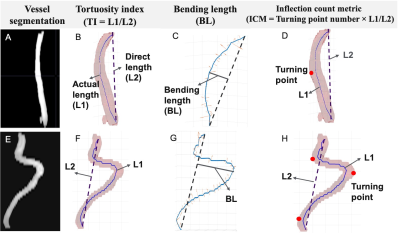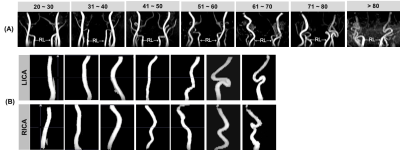Zhe Sun1,2, Dengrong Jiang3, Marco Muccio1, Chenyang Li1,2, Zixuan Lin3, Peiying Liu3, Hanzhang Lu3, and Yulin Ge1
1Radiology, NYU Langone Health, New York, NY, United States, 2Vilcek Institute of Graduate Biomedical Science, New York University School of Medicine, New York, NY, United States, 3Radiology, Johns Hopkins University School of Medicine, Baltimore, MD, United States
1Radiology, NYU Langone Health, New York, NY, United States, 2Vilcek Institute of Graduate Biomedical Science, New York University School of Medicine, New York, NY, United States, 3Radiology, Johns Hopkins University School of Medicine, Baltimore, MD, United States
More tortuous vascular appearance, as well as reduced hemodynamic properties, were observed with aging; Mean and maximum blood velocity were found to be associated with the morphological parameters, indicating that high blood velocity and wall shear stress could induce arterial tortuosity.

Figure1. Segmentation as well as the centerline of the vessel were acquired. The measurements included tortuosity index (TI), bending length (BL), and inflection count metric (ICM). (A) Left ICA vessel segmentation of a young subject; (B) TI is actual length over direct length; (C) BL is the distance between the foremost points on the vessel path
and the start-end points link; (D) ICM is the product of turning points number and TI. (E-H) are corresponding vessel segmentation and measurements of an old subject.

Figure 2.
Illustrations of vessel segmentation
for each decade over the
lifespan. (A) Coronal TOF images of subjects from each decade demonstrate arteries become more tortuous with aging. (B) Upper: left ICA segmentation results
of subjects from 20
to 80; Lower: right ICA segmentation results
of subjects from 20
to 80.